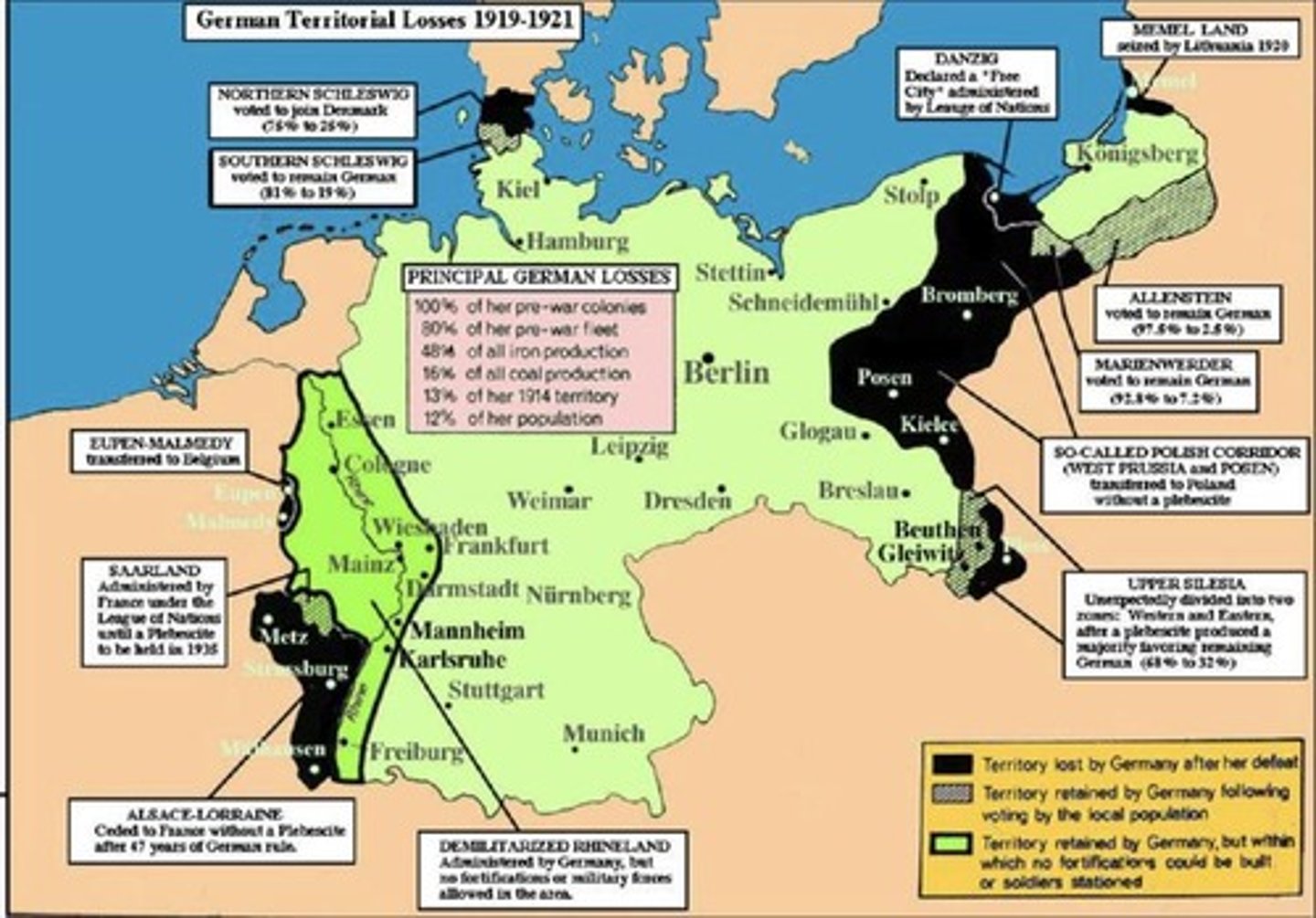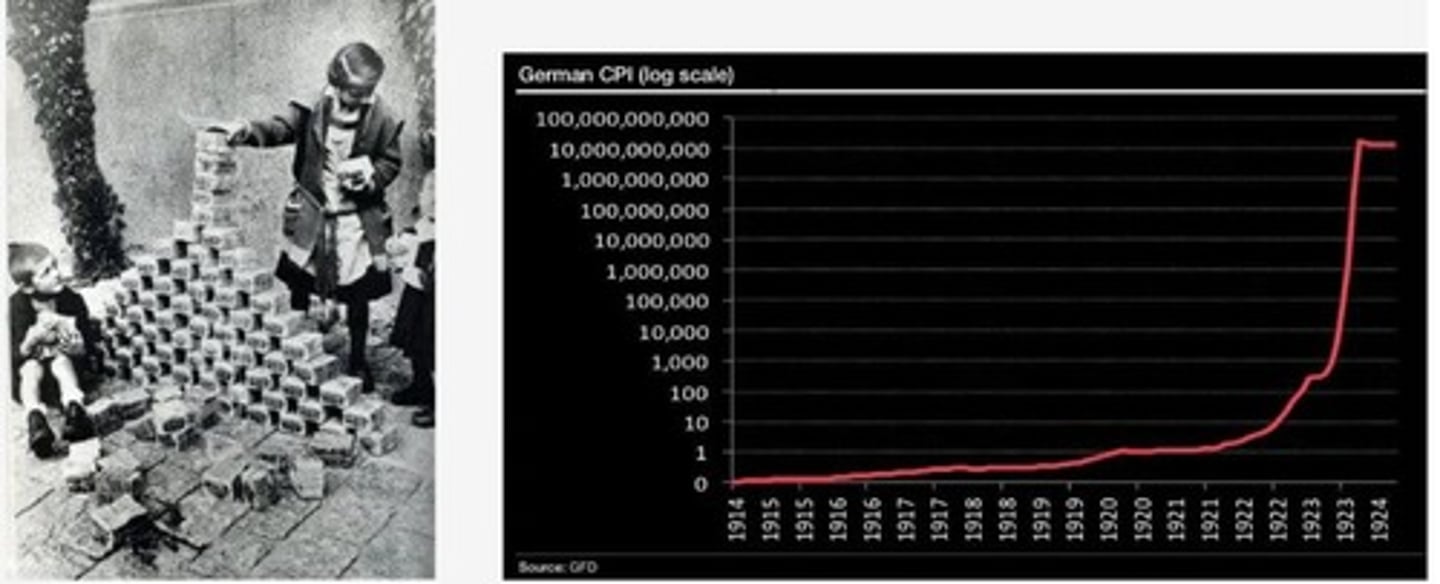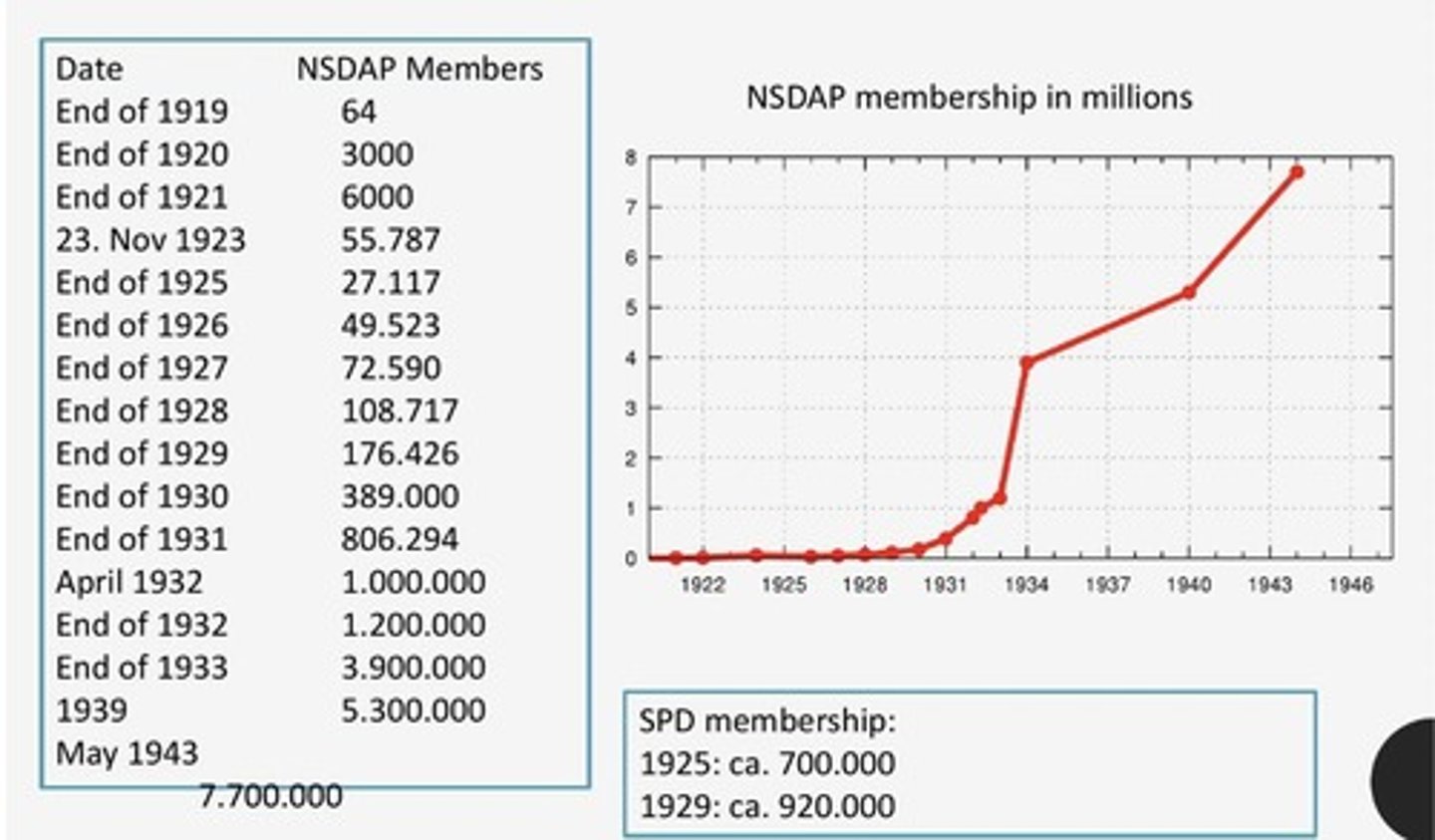Inside Nazi Germany: Origins, Rise, and Dictatorship
1/66
There's no tags or description
Looks like no tags are added yet.
Name | Mastery | Learn | Test | Matching | Spaced |
|---|
No study sessions yet.
67 Terms
What was the original name of the Nazi Party?
The German Workers Party (DAP), formed in January 1919.
Who was Adolf Hitler and what was his role in the Nazi Party?
Hitler was born in Austria in 1889, became an army informant, joined the Nazi Party in 1919, and rapidly transformed it into the 'Hitler Movement.'
What were some key nationalist demands of the Nazi Party's 1920 program?
Union of all Germans for a Greater Germany, land for colonies, citizenship tied to German blood, and prevention of non-German immigration.
What economic demands were included in the Nazi Party's 1920 program?
Banning income not earned by work, nationalization of publicly owned businesses, profit-sharing from large companies, and land reform.
What were the consequences of the Versailles Treaty for Germany?
Loss of colonies and territory, war reparations, military limitations, and the 'war guilt clause' (Article 231).

What were the Central Powers in World War I?
Germany, Austria-Hungary, and the Ottoman Empire.
What were the Allied Powers in World War I?
Great Britain, France, Russia, Japan, Italy (from 1915), and the US (from 1917).
What significant events occurred in Germany in November 1918?
Mutiny of naval troops, abdication of Kaiser, and proclamations of a republic.
What characterized the political landscape in Germany after World War I?
A massive political crisis, power vacuum, and the birth of a republic in defeat.
What were the key characteristics of the Nazi Party?
Violent, radical, nationalist, antisemitic, racist, xenophobic, and 'socialist' under Hitler's leadership.
How did Germans react to the end of World War I?
They voted for a constitutional assembly and continued revolutionary activities, leading to the Weimar Republic.
What was the 'Stab-in-the-back' legend?
A conspiracy theory suggesting that Germany's defeat in WWI was due to betrayal by Jews and socialists.
What were the political threats to the Weimar Republic from 1918 to 1923?
Instability from leftist revolts (e.g., Spartacist Revolt) and rightist coups (e.g., Kapp Putsch and Hitler's Beer Hall Putsch).
What was the membership growth of the Nazi Party from January 1921 to November 1923?
From 2,000 in January 1921 to 50,000 in November 1923.
What economic crisis did Germany face in 1923?
Hyper-inflation due to reparation payments and occupation of the Ruhr.

What was the Beer Hall Putsch?
A failed coup attempt by Hitler in Munich in November 1923, leading to his arrest.
What was the significance of the Nazi Party in the early 1920s?
It was a small, regional fringe party with limited membership, but Hitler's leadership made it a nationally known figure after the Beer Hall Putsch.
What economic stabilization measures were taken in Germany after 1923?
Introduction of the Rentenmark and new international treaties to renegotiate reparations.
What cultural changes occurred in Germany during the 'Golden Twenties'?
Universal suffrage, the emergence of the 'New Woman,' and a vibrant cultural scene in arts and literature.
What type of government did Germany have during the rise of the Nazis?
A Federal Republic with a president, a chancellor, and parliament.
What was the significance of Paragraph 48 in the Weimar Constitution?
It allowed the president to declare a state of emergency and rule by decree, bypassing parliament.
What major economic crisis occurred in Germany in 1923?
Hyperinflation and economic instability.
What was the outcome of Hitler's trial in 1924?
He was charged with high treason and sentenced to a minimum of 5 years in prison but was released after one year.
How did Hitler redefine the Nazi Party after his release?
The ban on the Nazi Party was lifted in 1925, and it began to operate within the rules of parliamentary politics.
What was the Nazi Party's strategy for gaining support in the late 1920s?
Mobilization, constant campaigning, and presenting themselves as a legitimate political option.
What was the significance of the Dawes Plan in Nazi propaganda?
It was portrayed as a chain holding back the German people, emphasizing the need for liberation.
What was a key tactic used by Hitler in his speeches by 1928?
He adopted a more moderate tone, avoiding direct attacks on Jews to appeal to a broader audience.
What was the political context in Germany leading up to the Nazi rise?
Mass unemployment, fear of communism, and a crisis of democracy with collapsing coalition governments.
What event marked the last 'free' election in Germany?
The election on March 5, 1933, where Nazis gained 43.9% of the votes.
What was the Enabling Act of March 23, 1933?
It allowed Hitler to govern without parliamentary control for four years and pass laws independently.
What was the purpose of the National Boycott on April 1, 1933?
To economically isolate Jewish businesses and individuals.
What was the 'Law for the Restoration of the Professional Civil Service'?
A law allowing the removal of Jews from civil service positions based on ancestry.
What was the impact of the 'Law Against the Overcrowding of German Schools and Universities'?
It limited the number of Jewish students allowed in schools and universities, drastically reducing their enrollment.
What actions did the Nazis take against trade unions in May 1933?
They occupied trade union offices and seized their assets.
What was the significance of the July 23, 1933 law?
It outlawed the establishment of new political parties, consolidating Nazi power.
What was the political strategy of the Nazis regarding the fear of communism?
They used the fear of communism to draw support from various segments of society.
How did Hitler's appointment as Chancellor on January 30, 1933, affect his power?
It was seen as a 'seizure of power' by Hitler, while elites believed they could control him.
What was the role of propaganda in the Nazi rise to power?
It was used to shape public perception and present the Nazis as the solution to Germany's problems.
What was the significance of the Reichstag fire on February 27, 1933?
It led to the emergency decree allowing mass arrests and the suppression of political opposition.
What was the Nazi Party's membership growth by the end of 1929?
The party had recruited 170,000 devoted followers.

What was the effect of the Wall Street Crash in October 1929 on Germany?
It exacerbated the economic crisis, leading to mass unemployment and social unrest.
What were the local actions taken against political enemies from February to April 1933?
Unregulated concentration camps were established, targeting communists and socialists.
What was the purpose of the Laws on the Coordination of the Länder in March/April 1933?
To centralize power by appointing Reich Governors to the Länder instead of allowing elections.
What significant change occurred on January 30, 1934, regarding the Länder?
The Law on 'Reform of the Reich' transferred sovereign rights of the Länder to the Reich.
What event is referred to as the Night of the Long Knives?
A purge on June 30/July 1, 1934, where SA leaders and conservative figures were murdered.
Who were some notable figures murdered during the Night of the Long Knives?
Ernst Röhm, Gregor Strasser, and General Kurt von Schleicher.
What was the general reaction of the German population to the murders during the Night of the Long Knives?
Fear and silence dominated, with some approval and relief among those influenced by Nazi propaganda.
What was the significance of August 2, 1934, in Nazi Germany?
Hitler declared himself Führer and Chancellor after Hindenburg's death.
How did Hitler build a dictatorship in Germany?
Through constitutional means, such as special ordinances and the Enabling Act, and through violence against opponents.
What was the Enabling Act?
It transferred legislative powers to the Chancellor, allowing Hitler to make laws without parliamentary approval.
What are the main pillars of power in Nazi Germany?
Adolf Hitler, the NSDAP (Nazi Party), the state, the police (including SS and Gestapo), and the army.
What characterized the Nazi Party's structure?
It was hierarchical, centralized, and pervasive, with regional leaders (Gauleiter) having significant autonomy.
What does the term 'Gleichschaltung' refer to in Nazi governance?
The process of coordinating and bringing various institutions and society into line with Nazi ideology.
What was the Führerprinzip?
The leadership principle emphasizing authority, responsibility, and individual initiative within the Nazi framework.
What was the role of Richard Walther Darré in Nazi agricultural policy?
He led the Nazi Agrarian Policy department and took control of agricultural associations and state policy.
What was the Reich Food Estate?
Established in September 1933, it regulated food production and operated independently of the Ministry of Food and Agriculture.
How did the Nazi regime interact with civil society?
It took over organizations like farmers' unions and cooperatives, exerting control over civil society institutions.
What was the reaction of the German people to the Nazi regime's actions?
Responses varied from fear and resignation to some approval of the regime's actions as necessary for order.
What were the implications of the Nazi party's rise for political parties and civil society?
There was a profound alteration in the balance of power, leading to the suppression of political parties and civil society.
What does the term 'polycracy' refer to in the context of Nazi governance?
The existence of multiple overlapping authorities and organizations, leading to competition and conflicts of interest.
What was the significance of the Nazi party's early character and goals?
It was characterized by nationalism, demands for unity, and a racist and anti-Semitic ideology.
How did Hitler come to power?
He was appointed Chancellor by the German president.
What was the reaction of Germans to the aftermath of World War I?
Many voted for parties that supported peace and a parliamentary republic.
What did Hitler promise in the 1930 party manifesto?
He promised to end democracy.
What were some of the legal means Hitler used to gain power?
Imprisoning political opponents, using special ordinances, and passing the Enabling Act.
What was the role of the SS and Gestapo in Nazi Germany?
They were responsible for enforcing Nazi policies through intimidation, violence, and surveillance.
What were the opposing interpretations of Hitler's role in the Nazi state?
Debates exist between viewing him as a 'master of the Third Reich' versus a 'weak dictator' and the nature of the state as 'totalitarian' versus 'chaotic.'